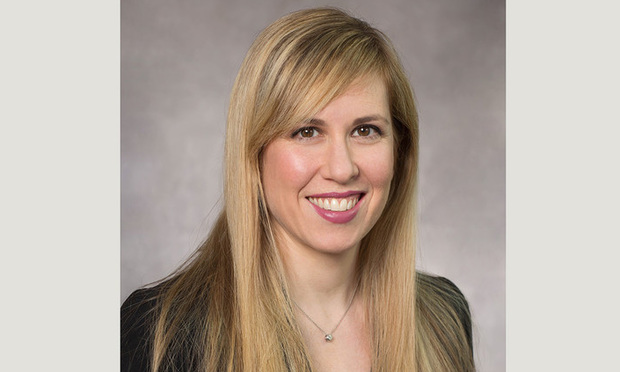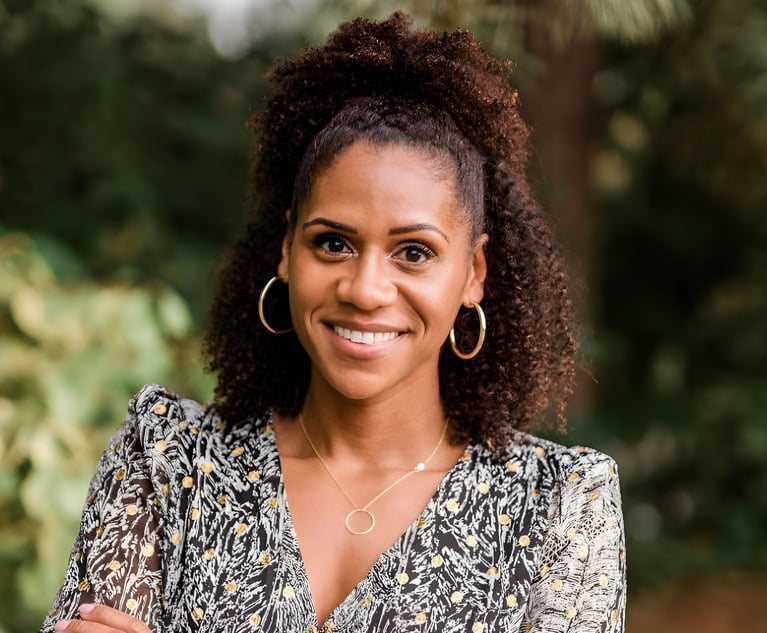The Mansfield Rule: Lessons for Every Legal Organization
Have you heard of the Mansfield Rule yet? It seems to be the phrase on the tip of everyone’s tongue in diversity and inclusion circles these days.
August 02, 2019 at 12:42 PM
6 minute read
 Meri Kahan of Saul Ewing Arnstein & Lehr. (Photo: Courtesy Photo)
Meri Kahan of Saul Ewing Arnstein & Lehr. (Photo: Courtesy Photo)
Have you heard of the Mansfield Rule yet? It seems to be the phrase on the tip of everyone’s tongue in diversity and inclusion circles these days.
If you haven’t heard of the rule, a quick introduction is in order. Mansfield 2.0 (indicating the second year of the program) is the brainchild of Diversity Lab, an incubator for innovative ideas to boost diversity, and requires that law firms consider at least 30% women, racially and ethnically diverse, and LGBTQ+ attorneys for promotions, senior level hiring, significant leadership roles and inclusion on pitch teams. It is a framework to ensure that firms—which are notorious for unsuccessful diversity hiring, elevation, leadership, and retention efforts—consistently and consciously consider diversity when making these important decisions.
If this has a familiar ring to it, that is because the Mansfield Rule was inspired by the NFL’s Rooney Rule, which requires NFL teams to interview at least one minority candidate for head coach vacancies. Since its adoption in 2003, a diverse candidate is now about 20% more likely to get a coaching job.
Why is it on the tip of everyone’s tongue? Because just two years into the program, we are seeing changes in a field that has been struggling to embrace diversity in an impactful way. “We have seen firms meaningfully increase the diversity of their candidate pools since joining the Mansfield Rule,” said Natalia Marulanda, Diversity Lab’s Mansfield Rule and knowledge sharing specialist. “For example, before joining the Mansfield Rule, only 12% of firms were tracking the diversity of their candidate pools for leadership positions. Now, 100% of participating firms are tracking these and other key metrics.” Tracking is a key step to not only establish a baseline but also increases transparency and accountability in an organization.
My firm, Saul Ewing Arnstein & Lehr, along with a number of other Philadelphia Diversity Law Group member firms, recently completed the Mansfield 2.0 certification process. In my experience as the Assistant Director of our firm’s mid- and senior-level associate hiring (categories to which the Mansfield Rule applies), it has been a catalyst for discussions with attorneys that are both more frank and more frequent about the importance of considering a diverse slate of candidates. As a result of the Mansfield Rule’s requirements, the firm is also more focused on improving tracking and documentation practices and increasing transparency around decision-making processes.
Diversity Lab just closed enrollment for the 3.0 iteration of the Mansfield Rule certification process. They also launched a new version being rolled out for legal departments, which requires slightly different metrics. But what can an interested firm do if it did not apply for The Mansfield Rule 3.0? And what about smaller firms or other types of legal organizations that are striving to create change but are not eligible to participate?
I would like to suggest that attorneys at these organizations take a look at the big picture lessons behind the Mansfield Rule. And I challenge you to draw from the valuable lessons of Arabella Mansfield—the first female lawyer in the United States—and formally or informally integrate these lessons into your place of work:
- Educate. Become familiar with the Mansfield Rule and what it does (and does not) hope to accomplish. The Diversity Lab’s website is a great first step. Then, educate your colleagues— including lawyers, administrators, and especially those in leadership roles—about the rule. Having these conversations, particularly against the larger framework of the importance of diversity for our profession, is a vital and necessary first step before any policies (formal or informal) can be adopted. Simply drawing attention to this topic by raising the collective consciousness is in itself a valuable tool.
- Propose. Think of a list of achievable steps to propose. For example, Diversity Lab cites research that transparency and accountability lead to diversity in leadership. For this reason, law firms are encouraged to draft descriptions of leadership positions. Consider suggesting drafting position descriptions to leadership at your organization; this should be an achievable step for a legal organization of any size.
- Implement. Most attorneys have an opportunity to make a difference in their own small way. Do you select your own project teams? Consider trying to create a team that includes a group that is 30% women, racially and ethnically diverse, or LGBTQ+ attorneys. Or do you have input about who is elevated into leadership positions? Many smaller legal organizations handle decisions like these very informally—on an “ad hoc” basis. Formalizing processes like these—i.e., by requesting a formal “slate” of candidates (including 30% who fall into the Mansfield categories) can go a long way toward increasing diversity at the upper levels.
The ways to help make an impact are limitless. That said, a stark reality is that there will always be organizations resistant to change. But even informal adherence to the general concepts behind Mansfield can bring about significant results.
One final note: during this student fall recruiting season, attorneys at law firms (including the many groundbreaking firms that are already Mansfield certified), may want to consider drawing from the lessons of the Mansfield Rule when considering (and hiring) junior talent. This category is explicitly excluded from the Mansfield Rule, as many firms are successful in hiring diverse attorneys at the junior level (with the more challenging issue being retention of these attorneys). That said, all firms are not created equal, and some are more successful than others at hiring diverse talent at the junior levels.
I would suggest that all attorneys and staff reviewing resumes, extending callbacks and making hiring decisions bear in mind the 30% rule in a more informal way, with a specific eye toward including students who fall into a variety of the following categories: racial and ethnic diversity, LGBTQ+ candidates, women, and students with disabilities—the latter being the most recent category added for Mansfield 3.0. If you are asked to interview students on campus, take a second look at your suggested “callback” list before you hand it over to the recruiting department, bearing in mind these categories.
It is not practical to expect any concept to single-handedly undo generations of deeply rooted organizational culture overnight. But the Mansfield Rule seems to be chipping away at some of these norms and it is exciting to be a part of this process. Consider joining in and applying some of these lessons to your own organization. And before you know it, the Mansfield Rule will be on the tip of your tongue, too.
Meri J. Kahan is the assistant director of attorney recruiting for Saul Ewing Arnstein & Lehr. In this role she handles both lateral associate recruiting and the summer associate program for the firm’s 16 offices. She sits on both the firm’s hiring committee and diversity and inclusion committee.
This content has been archived. It is available through our partners, LexisNexis® and Bloomberg Law.
To view this content, please continue to their sites.
Not a Lexis Subscriber?
Subscribe Now
Not a Bloomberg Law Subscriber?
Subscribe Now
NOT FOR REPRINT
© 2025 ALM Global, LLC, All Rights Reserved. Request academic re-use from www.copyright.com. All other uses, submit a request to [email protected]. For more information visit Asset & Logo Licensing.
You Might Like
View All


Best Practices for Conducting Workplace Investigations: A Legal and HR Perspective
9 minute readTrending Stories
- 1We the People?
- 2New York-Based Skadden Team Joins White & Case Group in Mexico City for Citigroup Demerger
- 3No Two Wildfires Alike: Lawyers Take Different Legal Strategies in California
- 4Poop-Themed Dog Toy OK as Parody, but Still Tarnished Jack Daniel’s Brand, Court Says
- 5Meet the New President of NY's Association of Trial Court Jurists
Who Got The Work
J. Brugh Lower of Gibbons has entered an appearance for industrial equipment supplier Devco Corporation in a pending trademark infringement lawsuit. The suit, accusing the defendant of selling knock-off Graco products, was filed Dec. 18 in New Jersey District Court by Rivkin Radler on behalf of Graco Inc. and Graco Minnesota. The case, assigned to U.S. District Judge Zahid N. Quraishi, is 3:24-cv-11294, Graco Inc. et al v. Devco Corporation.
Who Got The Work
Rebecca Maller-Stein and Kent A. Yalowitz of Arnold & Porter Kaye Scholer have entered their appearances for Hanaco Venture Capital and its executives, Lior Prosor and David Frankel, in a pending securities lawsuit. The action, filed on Dec. 24 in New York Southern District Court by Zell, Aron & Co. on behalf of Goldeneye Advisors, accuses the defendants of negligently and fraudulently managing the plaintiff's $1 million investment. The case, assigned to U.S. District Judge Vernon S. Broderick, is 1:24-cv-09918, Goldeneye Advisors, LLC v. Hanaco Venture Capital, Ltd. et al.
Who Got The Work
Attorneys from A&O Shearman has stepped in as defense counsel for Toronto-Dominion Bank and other defendants in a pending securities class action. The suit, filed Dec. 11 in New York Southern District Court by Bleichmar Fonti & Auld, accuses the defendants of concealing the bank's 'pervasive' deficiencies in regards to its compliance with the Bank Secrecy Act and the quality of its anti-money laundering controls. The case, assigned to U.S. District Judge Arun Subramanian, is 1:24-cv-09445, Gonzalez v. The Toronto-Dominion Bank et al.
Who Got The Work
Crown Castle International, a Pennsylvania company providing shared communications infrastructure, has turned to Luke D. Wolf of Gordon Rees Scully Mansukhani to fend off a pending breach-of-contract lawsuit. The court action, filed Nov. 25 in Michigan Eastern District Court by Hooper Hathaway PC on behalf of The Town Residences LLC, accuses Crown Castle of failing to transfer approximately $30,000 in utility payments from T-Mobile in breach of a roof-top lease and assignment agreement. The case, assigned to U.S. District Judge Susan K. Declercq, is 2:24-cv-13131, The Town Residences LLC v. T-Mobile US, Inc. et al.
Who Got The Work
Wilfred P. Coronato and Daniel M. Schwartz of McCarter & English have stepped in as defense counsel to Electrolux Home Products Inc. in a pending product liability lawsuit. The court action, filed Nov. 26 in New York Eastern District Court by Poulos Lopiccolo PC and Nagel Rice LLP on behalf of David Stern, alleges that the defendant's refrigerators’ drawers and shelving repeatedly break and fall apart within months after purchase. The case, assigned to U.S. District Judge Joan M. Azrack, is 2:24-cv-08204, Stern v. Electrolux Home Products, Inc.
Featured Firms
Law Offices of Gary Martin Hays & Associates, P.C.
(470) 294-1674
Law Offices of Mark E. Salomone
(857) 444-6468
Smith & Hassler
(713) 739-1250






